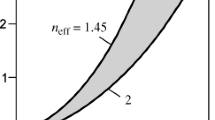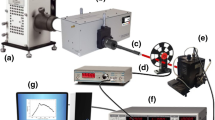Abstract
A self-normalized photoacoustic technique was applied for quantitative analysis of pigments embedded in solids. Paper samples (filter paper, Whatman No. 1), attached with the pigment: Direct Fast Turquoise Blue GL, were used for this study. This pigment is a blue dye commonly used in industry to dye paper and other fabrics. The optical absorption coefficient, at a wavelength of 660 nm, was measured for this pigment at various concentrations in the paper substrate. It was shown that Beer–Lambert model for light absorption applies well for pigments in solid substrates and optical absorption coefficients as large as \(220\,\hbox {cm}^{-1}\) can be measured with this photoacoustic technique.
Similar content being viewed by others
Avoid common mistakes on your manuscript.
1 Introduction
Optical properties in the UV–Vis are widely used in analytical chemistry. The optical absorption coefficient (at an adequate wavelength) is required for quantitative analysis. The easier way of measuring this optical parameter is for pigments in liquid solution. However doing this for pigments in solid substrates becomes a real problem. Special devices (integrating spheres) are required for this last case. The procedure consists in quantifying the fraction of light which is reflected and transmitted; the fraction of absorbed light, named as absorptance, is then obtained as the complement of these two. In this paper, a very easy way of measuring the optical absorption coefficient of pigments attached in solid substrates is described. The experimental procedure involves photoacoustic technique in the modulation frequency domain [1]. The optical absorption coefficient (at 660 nm) of the pigment Direct Fast Turquoise Blue GL (Chemical formula \(\hbox {C}_{32}\hbox {H}_{14}\hbox {CuN}_{8}\hbox {Na}_{2}\hbox {O}_{6}\hbox {S}_{2}\) and 780.17 \(\hbox {g}\cdot \hbox {M}^{-1}\) molecular weight), attached at different concentrations inside paper substrates (Whatman No. 1), was measured for this goal.
2 Theoretical and Experimental Details
Figure 1 represents a cross section of the photoacoustic (PA) experimental setups for the two photoacoustic configurations used in this work (Fig. 1a for the transmission configuration and Fig. 1b for the front configuration). The experimental procedure for optical absorption coefficients measurements (\(\beta \)) of pigments attached in a solid substrate with thickness l, involves taking the PA signals, as function of the modulation frequency (f), for the two photoacoustic configurations. The self-normalized PA methodology involves the ratio of PA signals, \(\delta P_{{\textit{SN}}}\), in the transmission (\(\delta P_{T}\)) and front (\(\delta P_{F}\)) configurations \(\delta P_{{\textit{SN}}}=\delta P_{T}/\delta P_{F}\). Taking the one-dimensional heat diffusion model through one-layered sample and considering a heat source generated by the absorption (following the Beer–Lambert model) of modulated light, it can be shown that the self-normalized signal is given by [1]
In this equation, \(b_{{\textit{gm}}}\) is the ratio of thermal effusivities for media g (air in this case) and m (sample under study), \(r=\beta /\sigma _{m}\), where \(\sigma _{m}= (1+i)(\pi f/\alpha )^{1/2}\), and \(\alpha \) is the sample’s thermal diffusivity.
For a weakly absorbing sample, m, in the thermally thick regime, it can be shown that this self-normalized signal simplifies to
The tangent of the self-normalized phase from this last equation can be written as
where \(P=\beta \left( {\frac{\alpha }{\pi }} \right) ^{\frac{1}{2}}\). Optical absorption coefficient can be obtained from parameter P if sample’s thermal diffusivity is known.
3 Experimental Details
Stock solution at 1.346 mM was prepared by diluting 105 mg of the dye in 100 ml of distilled water. Sample papers at various dye concentrations were obtained by immersion (for some seconds) inside solutions obtained from the stock by appropriate dilutions (Table 1, column 1); the papers were dried for one day at ambient temperature.
Self-normalized PA signals in a modulation frequency range of 1 Hz to 101 Hz, in steps of 2 Hz, where obtained for each sample. Light source consisted of a diode laser at 660 nm wavelength (Thorlabs, model HL6545MG—660 nm). The tangent of the self-normalized phases was plotted as a function of the modulation frequency and, inside an adequate frequency range, they were fitted to Eq. 3.
4 Results
Figure 2 shows a typical behavior of the tangent of the self-normalized phase, as a function of the modulation frequency, for a paper sample at 0.2692 mM of the dye. The continuous line in this figure represents the best fit to Eq. 3. The value of parameter P obtained in this case was of 5.03521.
Thermal diffusivity for this kind of paper was measured with other related photothermal technique [2]. The sample was immersed in the concentrate stock solution to fulfill the theoretical requirements in this case (very strong optical absorption). Figure 3 shows the tangent of the self-normalized phase. The analytical treatment to obtain the sample’s thermal diffusivity is shown on the same plot. The thermal diffusivity for this paper sample obtained with this methodology was of \(\alpha =0.0025\,\hbox {cm}^{2}\cdot \hbox {s}^{-1}\). This same value of thermal diffusivity was used to obtain the optical absorption coefficient for all samples. According to the theoretical scheme this optical parameter, at 660 nm, resulted in \(178.49\,\hbox {cm}^{-1}\) for the sample at 0.2692 mM. The same experimental procedure was followed for the other samples as to obtain their optical absorption coefficients. The results are summarized in Table 1, column 2.
Figure 4 shows the optical absorption coefficient for the samples studied in this work (Table 1, column 2), as a function of the dye concentration. The linear behavior of this optical parameter as a function of the dye’s concentration in the paper substrate is evident, showing that the Beer–Lambert model applies well, at least for samples dyed up to 0.4037 mM. The continuous line represents the best linear fit for purpose of obtaining the molar absorption coefficient, at 660 nm, of this dye in this paper substrate. The corresponding value was of 324 862 \(\hbox {cm}^{-1}\cdot \hbox {M}^{-1}\).
All of the fitting procedures were carried out using commercial software (origin \(6.1^{{\mathrm{TM}}}\)), using as measurements of uncertainty the standard error on the fitted parameters from the software.
5 Conclusions
A photoacoustic technique for the measurements of the optical absorption coefficient of pigments attached to a solid substrate was presented. Its potential application for quantitative optical characterization of papers or fabrics was demonstrated by measuring the optical absorption coefficient of Direct Fast Turquoise Blue GL dye, at 660 nm. The same procedure can be done for the same or other dye at other wavelength by just taking the appropriate light source.
References
J.A. Balderas-López, I.S. Martínez-López, M. León-Martínez, Y.M. Gómez y Gómez, M.E. Bautista-Ramírez, A. Muñoz-Diosdado, G. Gálvez-Coyt, Rev. Mex. Fís. 55, 292 (2009)
J.A. Balderas-López, A. Mandelis, Rev. Sci. Instrum. 74, 5219 (2003)
Author information
Authors and Affiliations
Corresponding author
Rights and permissions
About this article
Cite this article
Balderas-López, J.A., Gómez y Gómez, Y.M., Bautista-Ramírez, M.E. et al. Self-Normalized Photoacoustic Technique for the Quantitative Analysis of Paper Pigments. Int J Thermophys 39, 37 (2018). https://doi.org/10.1007/s10765-018-2358-3
Received:
Accepted:
Published:
DOI: https://doi.org/10.1007/s10765-018-2358-3








